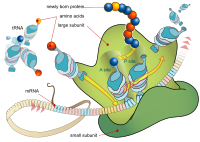
Photo from wikipedia
Many bacterial pathogens secrete virulence factors, also known as effector proteins, directly into host cells. These effectors suppress pro-inflammatory host signaling while promoting bacterial infection. A particularly interesting subset of… Click to show full abstract
Many bacterial pathogens secrete virulence factors, also known as effector proteins, directly into host cells. These effectors suppress pro-inflammatory host signaling while promoting bacterial infection. A particularly interesting subset of effectors post-translationally modify host proteins using novel chemistry that is not otherwise found in the mammalian proteome, which we refer to as ‘orthogonal post-translational modification’ (oPTM). In this Review, we profile oPTM chemistry for effectors that catalyze serine/threonine acetylation, phosphate β-elimination, phosphoribosyl-linked ubiquitination, glutamine deamidation, phosphocholination, cysteine methylation, arginine N-acetylglucosaminylation, and glutamine ADP-ribosylation on host proteins. AMPylation, a PTM that could be considered orthogonal until only recently, is also discussed. We further highlight known cellular targets of oPTMs and their resulting biological consequences. Developing a complete understanding of oPTMs and the host cell processes they hijack will illuminate critical steps in the infection process, which can be harnessed for a variety of therapeutic, diagnostic, and synthetic applications. Virulence factors from various bacterial pathogens catalyze post-translational modification of key host proteins, including phosphate β-elimination and phosphoribosyl-linked ubiquitination, to suppress host immune defenses and promote infection.
Journal Title: Nature Chemical Biology
Year Published: 2020
Link to full text (if available)
Share on Social Media: Sign Up to like & get
recommendations!